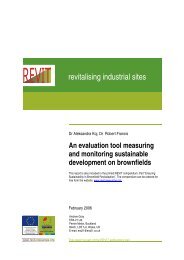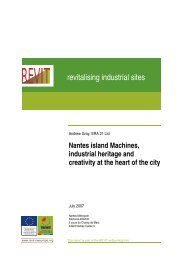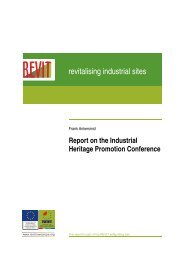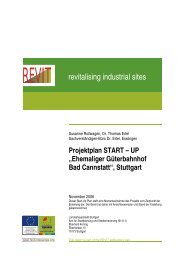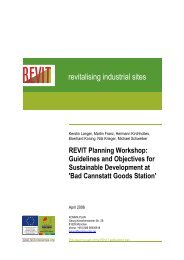REVIT Heritage Report.pdf
REVIT Heritage Report.pdf
REVIT Heritage Report.pdf
You also want an ePaper? Increase the reach of your titles
YUMPU automatically turns print PDFs into web optimized ePapers that Google loves.
Torfaen County Borough Council<br />
<strong>REVIT</strong>: A Review of the Conservation of Industrial <strong>Heritage</strong> Assets on Brownfield Sites<br />
The Brunel Saw Mills, 1814 is a Scheduled Ancient Monument and Grade I. the<br />
building that was to revolutionised timber preparation in the Dockyard. Designed by<br />
Marc Brunel it provided a mechanised approach to the whole process with steam<br />
power and reciprocating sawing machines linked by an overhead travelling crane<br />
system to timber storage yards and by underground canal to the South Mast Pond.<br />
The Ropery, 1786-91 is a Scheduled Ancient Monument and Grade I. The buildings<br />
of the Ropery form one of the finest integrated groups of 18th Century manufacturing<br />
buildings in Britain. Machinery dating from 1811 remains in regular use and on<br />
display to visitors.<br />
Hemp Houses and Spinning Room 1729- 1814 are a Scheduled Ancient Monument<br />
and Grade II*. They were built to provide storage space for hemp for ropemaking.<br />
The buildings retain many of their original fittings including much of their timber<br />
panelling.<br />
Hatchelling House 1786-91 is a Scheduled Ancient Monument and Grade II*. It is<br />
located at the north end of the Double Ropehouse and used by the Ropeyard’s<br />
hatchellers to comb the hemp fibres to straighten them before spinning.<br />
Yarn Houses, 1786-91 are a Scheduled Ancient Monument and Grade II* . The three<br />
buildings were used to store newly spun hemp yarns, a Tarring House, where the yarn<br />
was dipped in molten yarn for rot proofing and the Black Yarn House where the tarred<br />
yarn was dried prior to being returned to the Double Ropehouse to be formed into<br />
strand.<br />
No 1 Smithery 1808 is a Scheduled Ancient Monument and Grade I. The Smithery<br />
was built for the use of iron in ship building. The building is now the last structure at<br />
Chatham in need of significant restoration and is on English <strong>Heritage</strong>’s list of historic<br />
buildings ‘at risk’.<br />
No 1 Machine Shop, c 1860 is a Grade II* consisting of two single storey adjoining<br />
workshops, constructed to house the new machine tools introduced to the Dockyard<br />
for the construction of HMS Achilles, the first iron battleship to be built in a Royal<br />
Dockyard.<br />
The Clocktower Building 1723 is a Scheduled Ancient Monument and Grade II* and<br />
the oldest naval storehouse to survive in any of the Royal Dockyards, it dates from the<br />
reorganisation of the yard in the 1720’s. Built as a ‘present use store’ for materials and<br />
equipment needed by ships under construction and repair its top floor was used as a<br />
Mould Loft and the six ground floor bays at the north end of the structure were left<br />
open and used as saw pits. The Clocktower Building is now the Bridgewarden’s<br />
College of the University of Kent<br />
Anchor Wharf Storehouses 1778 – 1805 is a Scheduled Ancient Monument and<br />
Grade I consisting of two great storehouses on Anchor Wharf. At nearly 700 feet long<br />
(210 metres) it is the largest storehouse built for the Royal Navy in Britain. Together<br />
with surviving examples in Portsmouth they are some of the most significant examples<br />
of early industrial warehousing in Europe. The Fitted Rigging House and Storehouse<br />
No. 2 now houses the Museum of The Royal Dockyard<br />
Lower Boat House c.1820 is a Scheduled Ancient Monument and Grade II*. It was<br />
constructed during the early years of the 19th century as a shed for sided (squared)<br />
timber it later became a storehouse for ships’ boats.<br />
The Commissioners House, 1704 is a Scheduled Ancient Monument and Grade I is<br />
the oldest naval building to survive intact it was built for the Resident Commissioner,<br />
his family and servants. The building became the residence of the Port Admiral. The<br />
garden is open to visitors.<br />
Officers Terrace 1722-1733 is a Scheduled Ancient Monument and Grade I. It<br />
contains a terrace of 12 houses erected for the senior officers of the Dockyard.<br />
Captain of the Dockyard’s House c.1895 is a Scheduled Ancient Monument and<br />
Grade II* Listed. It was built as the residence of the Admiral Superintendent’s staff<br />
captain.<br />
0014021/JM/001 75





